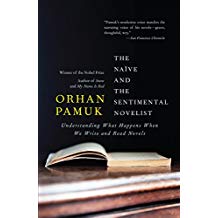The Naive and Sentimental Novelist: Understanding What Happens When We Write and Read Novels, Orhan Pamuk 2010
This book, based on the six Norton Lectures given by Pamuk in 2009 at Harvard, is a readable and fascinating excursion through the Nobel Prize winning Turkish novelist’s theory of the novel. Likening reading a novel to a landscape painting and writing to painting with words, Pamuk stresses the partnership between reader and writer in creating a world that is complete, engaging, and a combination of real and imagined (naive and sentimental) details all in service to the ‘center of the novel’, often hidden and difficult to ferret out but the original desire of the novelist is to explore that center. Character (frequently standing in for the whole landscape), plot (the line connecting Nabokov’s nerve ending, sphere of energy as seen through the eyes of the protagonist, time (linear and objective vs personal and subjective), using words and pictures (ekphrasis). The chess game between author and reader is built upon self-regard, distinction, and politics of representation. All in service to the center—a profound insight and opinion about life, a deeply embedded point of mystery. Every ‘tree in the landscape’ has been placed there to point to a deeper meaning. Reading a novel is the act of determining the center and real subject while deriving pleasure from the surface details, and the brilliance of a novel is determined by the distance from the center to the narrated story. Creating an enigma is the highest art!



